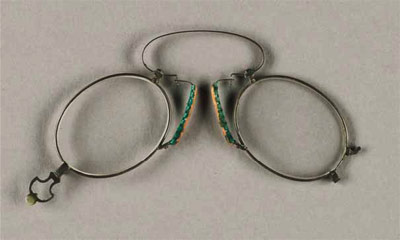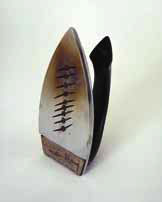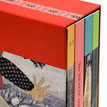Richard Deming
Don Joint
Nancy Kuhl
Duncan Hannah |
Objects of
Our Affection |

SECOND SIGHT:
WALT WHITMAN’S GLASSES
A yellowed note, folded in fourths, that accompanies a certain pair
of
well-worn glasses from the late nineteenth century reads simply and unsentimentally
enough, “Dear Mr. Johnston, I herewith fulfill my promise and
send the last pair of eyeglasses he ever used.” After the signature
a postscript
appears that establishes the significance of these particular glasses
by clarifying
to whom the pronoun “he” is referring: “I of course
mean Walt
Whitman.” Evidently one of America’s greatest visionaries
had weak eyes
that required correction if he were to read anything, even his own poems.
These
historic, curious glasses and the attendant note were sent from
Camden, NJ, by Whitman’s longtime personal housekeeper Mrs. Mary
O.
Davis, the widow of a sailor, who lived with and cared for the poet during
the last years of his life, until his death in 1892. Davis sent the glasses
to J.
H. Johnston on March 26th 1895, three years after the poet’s death.
Coming upon Walt Whitman’s glasses is indeed a strange thing, not
least because no photographs of him wearing his spectacles are known
to
exist. Thus, none of the major biographies include images of him wearing
either regular glasses (a pair of which can be found in the Library of
Congress’s Whitman collection) or the pince-nez style he seemed
to favor
in his final years. As the majority of images of Whitman are clearly
posed
and taken by professional studios, and because he is quite likely the
most
photographed American author of the nineteenth century, the absence of
a
bespectacled Whitmanian visage may have been a conscious choice.
Perhaps Whitman wished to seem sagacious with his long, chaotic beard
but worried that the glasses would make him seem more bookish and less
like “one of the roughs.”
The name of the makers of this particular pair of spectacles printed
on
the battered, leather carrying case is “Cooke and Brothers,” a
company of
opticians and jewelers once located at 35 S. 4th St. in Philadelphia,
PA.
Interestingly, the recipient of the glasses, Johnston, was himself a
jeweler,
if we take the addressee to be the J. H. Johnston who had been a friend
of
Whitman’s since the 1870s and with whom Whitman would often stay
when he visited New York City. There is room for hesitation in being
too
certain about this provenance, however, in that there was another person
in
Whitman’s life with a similar name. Dr. J. Johnston, a general
practioner
from Manchester, England, had been an ardent admirer of the poet and
was one of the circle of Whitman’s English disciples, a group that
included
no less a luminary than Bram Stoker, author of Dracula. In the late 1880s,
Dr. Johnston began a correspondence with Whitman and in 1890 traveled
from England to Camden for the sole purpose of meeting the poet in his
home at 328 Mickle Street. One could imagine such a person requesting
some souvenir of his hero in the wake of his death. It is more likely,
however,
that the glasses were sent to the first Johnston. Indeed, given their
close friendship, it would make sense that Johnston would ask for something
that personalized his memory of his friend with a kind of memento
amici. Davis does specify that these were the poet’s last glasses
and that she
is honoring a promise, which is more likely something that honors the
affection the two men shared. Additionally, in Horace Traubel’s
famous
multi-volume memoir of the time he spent with “the Good Gray Poet” in
his last years, we see a note from Johnston reprinted in which he urges
Whitman to find some home for his literary remains. Johnston insists
that
he himself does not have the capability or knowledge to serve as such
a de
facto executor, though he does negotiate purchasing from Whitman for
the
price of one hundred dollars the Charles Hine portrait that serves as
the
source for the Stephen A. Schoff engraving appearing at the beginning
of
the third edition (1860) of Whitman’s Leaves of Grass. Johnston
periodically
raised money for his friend and financially supported him in more
direct ways, and so the purchase might be a way of justifying that support
in various ways. Yet Johnston’s insistence on archiving indicates
he also had
a desire to preserve the material evidence of Whitman’s life. The
lenses
through which and by which the poet partook of texts and the worlds those
texts—even his own poems—made possible would thus have an
obvious auratic value Johnston would have wanted to see protected as
part of
Whitman’s legacy.
There is at least one specific report of the poet wearing the glasses.
On
the outside of the envelope containing Davis’s letter to Johnston,
someone
has written the note “Brinns, 332,” which is a reference
to Henry Bryan
Brinns’s A Life of Walt Whitman, a biography published by Methuen
and
Company in London in 1905. On the page indicated, one reads about
Whitman traveling to New York City (and at that point largely confined
to
a wheelchair) in the spring of 1889 to celebrate his annual reading of
his
lecture on Abraham Lincoln. Brinns describes Whitman, then in his ’70s,
as “hoarse and half-blind” and yet after taking the stage
and upon
“put[ting] on his glasses,” the poet, that quintessential
American bard, “got
immediately to business, reading with a melodious voice and easy manner.”
When one imagines the scene, one should have a specific element in
mind—given the prescription of his lenses, Whitman most likely
had to
hold his reading material relatively close to his face.
The question of what value such an item as this might have is another
matter. One could say that the glasses have no intrinsic research value,
nor
do they shed any light on Whitman’s perceptions of the world in
the way
that, for instance, knowledge of the health of El Greco’s eyes
might possibly
tell us about the elongated figures dominating the painter’s canvases.
Are Whitman’s glasses then just some collector’s fetish?
The question
comes, as these things do, to value. What do we value and why? What do
Whitman’s glasses provide us? Do they help us understand his life
better,
or help us to read his poems better? In their connection to Whitman’s
cultural,
daily material, the glasses are not a means to an end, but constitute
an end in and of themselves. One might see them as an instrument of divination,
a tool (or locus) summoning neither a muse or a spirit but the
material reality of the poet who, like anyone else, struggled against
the
infirmities of age and the limitations of the body. Yet, the glasses
make his
presence palpable in a way that we can recognize because they signify
not
simply that he lived but that he wrote poems in praise of the body despite
and because of its limitations. It is the very ordinariness of his glasses
that
make them important.
In the late photographs of Whitman, those in which he is ensconced in
his living room at his Mickle Street home, he is surrounded by books
and
papers. The glasses are the things that signify their part, however humble,
in Whitman’s struggle to bear down on the words that were his life,
a life
that ultimately must branch into ours for us to know it, to recognize
it, to
think again that its reality is also our reality. One could think of
all of the
extant images of Whitman as a body of materials signifying the poet’s
marked investment in a crass (or savvy) self-promotion, but that would
be
less than generous. Whitman’s poems were always about the poet
and his
poetry going out into the world and the world coming back into him by
means of his close attention to the things he saw. What more important
sign of that than the glasses through which he looked out and by means
of
which we can look back into him?
– Richard Deming

MAN RAY IRON
When I first saw the Man Ray iron I was told that he made
it
for his granddaughter, Naomi Savage.
I was mesmerized by it.
I still am.
My mind wandered to when I was a kid.
I had a green, orange and black checkered shirt.
It was my prized possession.
I wore it for class pictures in the third and fourth grades.
I wore it until it fell apart.
Looking at the iron, I thought, “What would I have done if Man
Ray
were my grandfather?”
What if he gave me this iron when I was a kid?
Would I have been compelled to iron my prized shirt
with this magical iron?
What would have happened?
Would my shirt have survived?
It was that cheap-feeling kind of nylon
but it made me feel so special when I wore it.
My prized shirt would have probably ripped and melted.
But, you never know, you just never know…
– Don Joint
—
DENISE DUHAMEL’s most recent poetry titles are Two
and Two (University
of Pittsburgh Press, 2005), Mille et un Sentiments (Firewheel,
2005) and
Queen for a
Day: Selected and New Poems (Pittsburgh, 2001). A winner of a National
Endowment
Fellowship in Poetry, she teaches poetry at Florida International University
in Miami.
DON JOINT is an artist who lives in New York City and Milton, PA. His
work has
been favorably reviewed in Art in America, The
New York Times and the
New York
Observer, and is the collections of the Oklahoma Museum of Art, the Cleveland
Museum of Art, and the Erie Museum of Art. He is represented by Francis
M.
Naumann Fine Art in NYC, Craig Flinner Contemporary in Baltimore, MD,
and
Galerie Marion Myer in Paris, France.
Purchase The
Sienese Shredder #2
Also by Don Joint
Collages
Collages
Collages
Back to The Sienese Shredder #2
|  |


